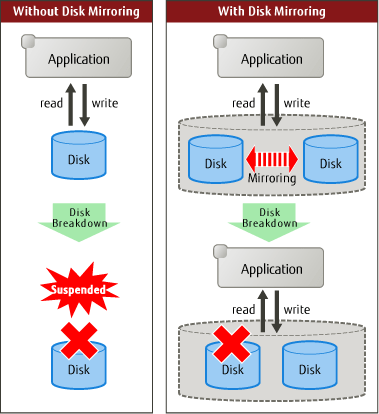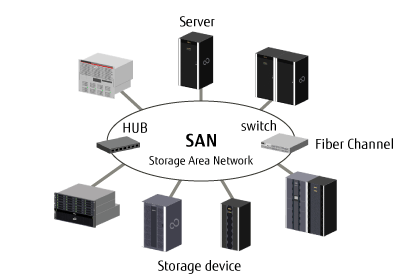GDS is a volume management software that improves the availability and manageability of disk-stored data. GDS protects data from hardware failures and operational mistakes, and supports the management of disk units.
GDS has following functions, which are closely related:
To improve availability of disk data
To improve manageability of disk data
GDS's mirroring function protects data from hardware failures by maintaining replicas of disk data on multiple disks. This allows users to continue to access the disk data without stopping the application in the event of an unexpected trouble.
Figure 2.9 Disk Mirroring

The GDS management functions reduce the system administrator's workloads of disk management. The user-friendly functions simplify management, and at the same time, prevent data corruption by operational mistakes.
In a SAN (Storage Area Network) environment, multiple servers can be connected to multiple disk units (see the figure below.). Disk-stored data can be accessed from those servers. This allows simultaneous access to a file system or database and improves the efficiency of data duplication between the servers and backup procedures. On the other hand, it also carries the risk of data damage, as multiple servers will compete to access the shared disk. Therefore, volume management functions suitable for the SAN environment are essential.
Figure 2.10 SAN (Storage Area Network)

GDS provides volume management functions suitable for SAN environments. GDS allows users to integrate management of all disk units connected to all servers, including local disk units that are connected to specific servers as well as disk units that are shared by multiple servers in a SAN environment.
Note
Except for a VMware environment, GDS cannot manage system disks in PRIMERGY.
GDS's main functions include:
Mirroring of system disks (Solaris server, PRIMEQUEST, and VMware environment)
Mirroring of shared disks
Mirroring of disk array units
Mirroring among servers which mirrors local disks of an operating node and a standby node through a network (Linux server)
Hot spare that automatically recovers mirroring in the event of a disk failure
Hot swap that replaces a failed disk without stopping applications
JRM (Just Resynchronization Mechanism) that pursues high-speed recovery of mirroring in the event of an unexpected system down or cluster failover
Integrated management and access control of disks in a SAN environment
Automatic configuration that recognizes physical connections to servers and disk units, registers the configuration information, and checks the connections (Solaris server only)
Concatenation that enables creation of large volumes of data
Striping that distributes load of access to disks
Logical partitioning that enables flexible use of disks
Snap-shot that supports backup minimizing the effect on core services
See
See "PRIMECLUSTER Global Disk Services Configuration and Administration Guide" for further details.